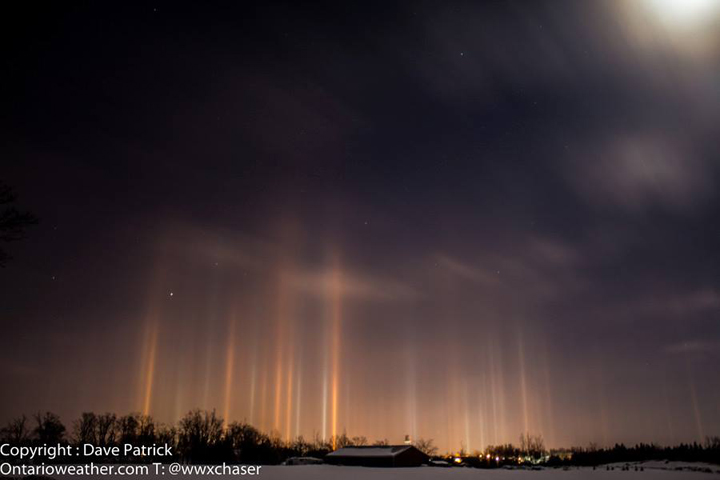TORONTO – Winter may be a time when you think it’s best to stay inside and stay nice and cozy, but if you do that, you’ll likely miss out on some cool winter weather phenomena.

Here are a few to look out for.
1. Sun pillars
Have you ever woken up and looked at the sunrise only to see a shaft of light reaching up into the sky? That’s called a sun pillar.
Sun pillars usually form around sunset or sunrise when sunlight reflects off falling ice crystals. Due to air resistance, the hexagonal, plate-like crystals lie flat, or horizontally, as they fall. Sunlight reflects off the crystals and create the sun pillar effect.
Sometimes human-made lights can create the same effect.
Streetlights can often make a beautiful scene that may look like something out of an alien invasion movie. But take heart: it’s just atmospheric science.
2. Sun halos and sun dogs
Ice crystals can also create sun halos and sun dogs. While these aren’t limited to just the winter, the cold, snowy season does offer more of an opportunity to see this beautiful phenomenon.
A sun halo is a ring of light around the sun. Sometimes it can just be white, but oftentimes you can get all the colours of the rainbow.
Halos form when light from the sun (sometimes it can even be the moon) is refracted — twice — by hexagonal ice crystals from high-level clouds. the Most often the ring is 22 degrees away from the sun.
Sun dogs — called parahelia or mock suns — are similar to halos, but only appear on either side of the sun. These are created when sunlight is refracted by hexagonal ice-crystals slightly larger than those that create sun halos. They must also be oriented horizontally, rather than randomly as in sun halos.
3. Snow rollers
These little guys are very rare and are created under very specific conditions.
Wind blows snow along the ground, which slowly accumulates. But it doesn’t create a snowball; instead a cylindrical shape is formed.
In order for snow rollers to form, you need a thin layer of wet, loose snow and a temperature just above 0 C. Underneath that, the snow has to be the kind where the wet snow won’t stick. And, of course, you need wind, but wind that won’t blow them apart.
4. Ice balls/boulders
Ice boulders are pretty cool.
These large balls of ice have been mostly witnessed in the Great Lakes region, and most recently in Lake Michigan.
They are believed to form during specific weather conditions (brisk winds, temperatures between -4 C to -1 C). Ice from the lake breaks up and the waves shapes them into spheres. They grow larger as more ice forms layers.
They can be quite a sight when they get as large as boulders (sometimes with diameters of a few metres) and are seen bobbing in the water. Sometimes they may be mistaken as rocks along the shore.
5. Ice shoves
- ‘Significant risk’: How will wildfires spread over the next two months?
- As Canada eyes AI growth, could electricity demands fuel climate change?
- London Drugs issues apology, says no evidence of compromised data in cyberattack
- B.C. fruit likely to be in short supply and expensive this year: produce retailers
This phenomenon can be scary — and destructive.
Sometimes free-floating lake ice is blown on shore by strong winds. The winds have to last for a long time and be strong enough to push heavy, large chunks of ice.
As the ice moves towards the shore, it slows down, creating a type of backlog or traffic jam. The ice all begins to accumulate and can tower as high as several metres. This massive load of ice then moves forward destroying anything in its path.
In May 2013, an ice shove crashed onto shore in Ochre Beach, Manitoba, destroying 12 homes.
Aside from these interesting winter weather phenomena, don’t forget that the colder weather makes it a great time to see the stars (less atmospheric disturbance).
So, though winter can be barren and cold, it can also provide you with some interesting and beautiful sights.





Comments